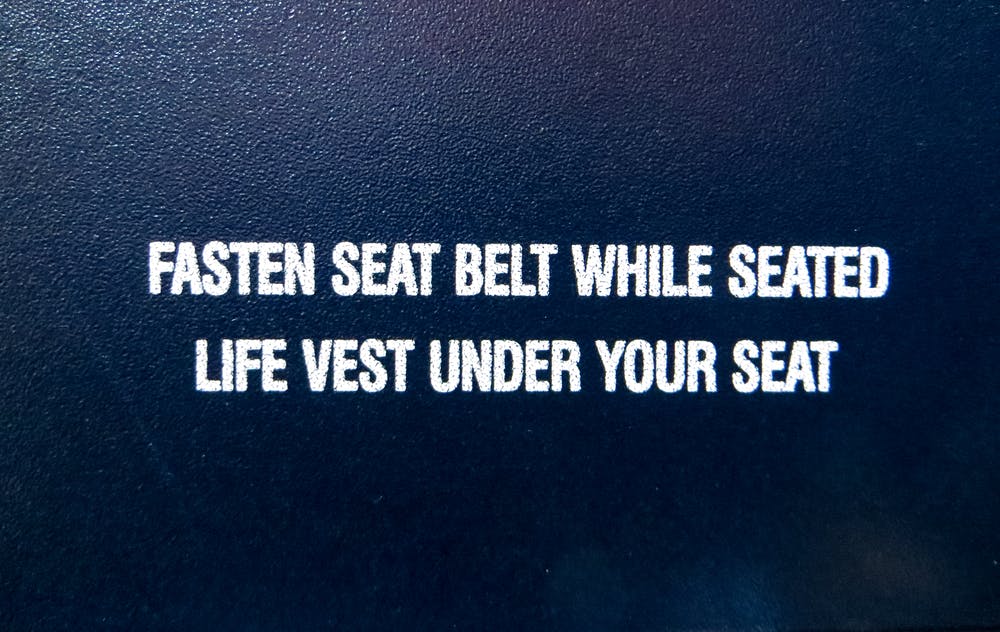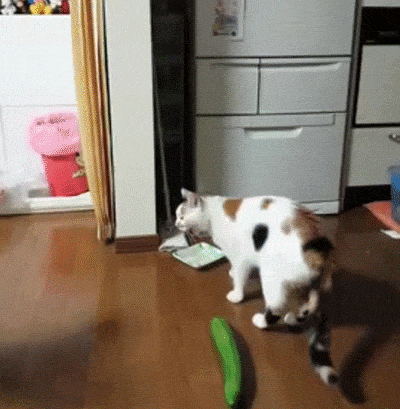– That is a Very Good Question
Living beings NEED fear. One of nature’s great gifts, its purpose ensures the continuation of life. Fear, like pain, is not pleasant, but it let’s us know something is wrong. Spontaneous, natural fear is healthy, such as the cat’s instinctive reaction to the cucumber (mistaking it probably for a snake). It may seem funny to us—and many practical jokes are played like this on humans as well—but it’s actually a very important and serious gift that keeps the cat safe.
Your brain stem works well when it protects you from dangers to ensure your survival. The fear response is perhaps the most basic and oldest wisdom of physical existence. Even a single cell amoeba has an “irritability” factor that causes it to withdraw from danger.
However, when you allow yourself to be stirred up into a state of fear by politicians, pundits, the media, social media, or your friends and family, so that you are reacting as if you are in actual, present, in-the-moment danger, you are being hoodwinked. You are terrorizing yourself for no good reason, because in that moment you are not in actual life or death danger. Nevertheless, your sympathetic nervous system kicks in and stress chemicals cascade through you, altering your heart rate, blood pressure, breathing, muscle tone, and thinking ability, as if you were currently being threatened.
Somebody or something has put a cucumber in your path.
And you let that happen over and over again, to your own detriment.
We humans have, like the cat above, instinctive fear reactions, one being the startle reflex. When something suddenly appears in the field of vision, or unexpectedly touches from behind, or there is a nearby, sudden, loud sound, these sensory (informational) stimuli, if intense, may cause a heightened response in which we jump, shriek, run away. Or if it is a milder surprise, less dramatically, the reaction is to freeze, withdraw (contract) and often touch the center of the chest, and focus attention. If we are mature, we quickly assess the danger, decide if it is real and how to react: to stay put (freeze); to engage the danger (fight); or to get the heck out of there (flee). Or, in the case of the cucumber, or someone playing a practical joke on us, relax or even laugh as we realize there is no danger here. A less evolved animal (like the cat) or an infant will react without immediately assessing the danger. But even the cat will eventually figure it out and might even start eating the cucumber.
Don’t let a cat be smarter than you!
Stop jumping every time somebody tries to manipulate you.
In cases of real—rather than imagined danger—fear is your friend. Your reflexes are designed by nature to respond to immediate, in-the-moment threats (or a perceived threat until it can be evaluated). When the proprioceptive system (literally “perception of self” or body in space) and the vestibular (balance) system are functioning well, and reflexes are well integrated, there is generally a physiological sense of safety—enough comfort in the body to go about daily routines without giving them a second thought. In the present moment there is no need for fear. The unconscious or subconscious awareness effectively says, “I’m OK. I know how to take care of myself.”
When we feel safe, life is generally easier, healthier, and more pleasant.
Sometimes, when we are bored or want an adrenaline rush, we seek fear, perhaps in order to feel more alive. Halloween scary houses, practical jokes, or watching horror movies are examples of our desire to experience fear as a thrill. That’s OK if it is not routine. But putting ourselves into a steady fear state May be likened to addiction. Adrenaline and cortisol might be natural drugs, but they are not meant by nature to be used so much so often.
Ask yourself: Do you experience real fear—leading to positive, natural reaction responses—or unhealthy states that mimic fear (bad fear)? In the case of bad fear, the word “fear” is actually used inaccurately, and covers up or clouds the real, underlying condition. There are many better words to use to distinguish between fear (the unconditioned, innate, mechanism built into our neurophysiology) versus learned, and usually dysfunctional, conditioned states that come from memories or projections about the future.
The Importance of Developing an Emotional Vocabulary
Let’s call “bad fear” what it is: insecurity, worry, anxiety, preoccupation, trepidation, nervousness, dread, distress, dismay, unease, foreboding, angst, apprehension, unrest, perturbation, disquiet, discomposure, concern, malaise, or even, in the extreme, paranoia, etc. And, even though anxiety, as an example of one of these, like the others is usually considered an emotion, it is not. It is a repeating thought that becomes a state of sensation that masquerades as emotion.
The above conditions cause sensations such as shivering, twitching, trembling, shuddering, quavering, quivering, jerking, fluttering, “butterflies in the stomach”, etc. None of these sensations function to protect us. They are not healthy reflex reactions, but rather symptoms of an uncomfortable state and are not natural or healthy responses to actual situations.
These thought-derived past memories or future projections run along as subconscious programs that can feel like emotions and then cause unnecessary stress resulting in biological and physiological reactions. These undercurrents of imagined or remembered dangers become dysfunctional patterns and habits that often hold the body in unnecessarily tight, protective postures. Such apprehensive states do not allow for the kind of ease and stillness from which peace, joy, and ease arise.
Think of the animal kingdom or even human infants. They exhibit innate fear, but not “bad fear.” For example, perhaps your dog hates thunderstorms and reacts with shaking, hiding, whining or other symptoms of distress; but when the thunderstorm is over, the behavior stops. It is very unlikely that your dog then spends any time or energy “thinking” about future thunderstorms or “remembering” past ones. The dog’s fear is bodily/sensory stimulation; but that human’s “bad fear” is from mental activity. Animals and infants have no vocabulary for their experience, only the experience itself in its raw form.
Just as the word “fear” is used inexactly, many of the above sensation words are mislabeled as emotions in mainstream psychology. Regardless, it’s truly important to have a highly developed vocabulary for these experiences, sensations, patterns and habits of thought and behavior. Imagine going to your doctor and saying, “I have a pain.” The doctor says, “Where.” You reply, “In my body.” “What part of your body?” “In my leg.” “Which leg?” “My right leg.” “Which part of your right leg?” “The lower part.” “Which lower part?” … until finally the area of the ankle is identified as the problem area. Then the doctor asks, “What kind of pain?” “Bad,” you answer. And so on and on. Being precise in definition requires a vocabulary that correctly isolates and accurately identifies and details the issue.
Please realize, however, that with an adequate understanding and vocabulary, these states masquerading as fear can serve—IN THE SHORT TERM—to accurately identify a problem and to be used consciously as a valuable protective mechanism.

If you have been threatened by a hurricane or tornado, for example, worry about future hurricanes or tornadoes would make you more likely to take necessary and beneficial precautions. Perhaps you need to buy insurance, to have fire drills, draw up an escape plan, or to check that tools and machinery are working properly.
If you have been diagnosed with a serious illness, worry or concern can make you change your behaviors, have regular health check ups, get your affairs in order. These kinds of thoughts and sensations can focus you.
However, continued worry without taking appropriate action, serves no purpose, other than to wreck havoc on well-being, depleting the intrinsic pleasures of being alive, and impeding personal growth. If we allow a concern to serve as an impetus towards positive action, it too can serve as a positive, so long as it does not linger beyond its functional value. Once we have taken whatever precautions we deem necessary, it is time to let the worry go. Once we have taken appropriate action, we have essentially trained our conscious mind to tell our subconscious mind and our neurophysiological system, “It’s OK. I know how to take care of myself.”
There are no guarantees. From the viewpoint of anxiety, none are strong enough. From the viewpoint of the natural state, none are necessary.
